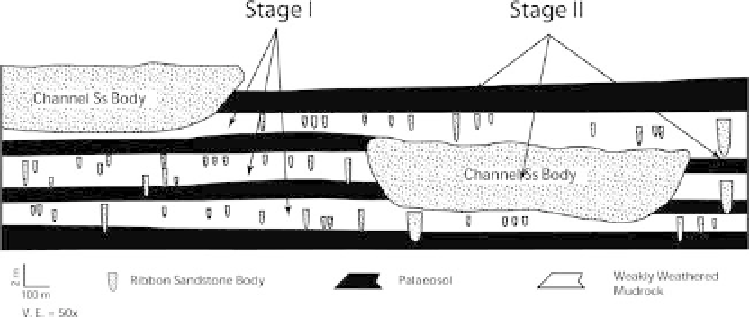Geoscience Reference
In-Depth Information
parent channel, once again following the regional
slope. Small channels on the floodplain are aban-
doned as flow is captured into a new trunk channel
similar in scale to the parent channel that initially
avulsed (Smith et al. 1989). Sedimentation rates
are low, allowing peat and soil formation to
resume on the floodplain. The new trunk channel
incises into its earlier avulsion deposits, creating a
new meander belt that has a width about twice the
meander amplitude. Incision occurs because all of
the water is now collected into one channel of
steeper slope than existed in Stage I. This meander
belt width is relatively narrow and only a small frac-
tion of the floodplain deposits are reworked into
meander belt deposits; the bulk of the floodplain
deposits consists of Stage I avulsion fill (Fig. 4).
In the Red Hill outcrop, Stage I deposits are
characterized by packages of red hackly weathering
mudstones, faintly laminated siltstones with gently
inclined bedding and very fine sandstones exhibit-
ing cross-bedding cut-and-fill structures and flat-
based convex-upwards bars that pinch-out laterally
over tens of metres (ribbon sandstones of Fig. 4).
The bars are flat-laminated and thinly bedded,
with bedding surfaces often littered with plant
debris. These sandstones are interpreted as deposits
of proximal splays and splay-channel complexes
while the siltstones and mudstones accumulated in
ponds and more distal portions of the splay.
The Stage I deposits at Red Hill contain the
fossil-bearing facies with a variety of articulated,
closely associated and isolated skeletal remains.
Stage II sedimentation is represented by floodplain
palaeosols identified by increased clay content,
extensive slickenside surfaces, abundant caliche
nodules up to 1 cm in diameter and root traces.
Whether peats of palaeosols form during this stage
depends upon whether the water table in the avul-
sion deposits remains high or is lowered as waters
are collected into the more efficient single-thread
channel of the newly forming meander belt. At the
western end of the outcrop channel belt deposits
are found. There are four avulsion cycles within
the sequence exposed at the east end of the Red
Hill outcrop. The earliest of these cycles (Fig. 5)
shows the most extensive Stage I deposits (around
3 m thick) and is the primary fossiliferous zone at
Red Hill, the source of the material on which this
palaeoecological analysis is based. The thickness
of the Stage I deposits in this cycle may reflect
greater proximity to the parent channel at the time
of that particular avulsion event. Successive
Stage I packages are thinner (less than 2 m thick).
Taphonomic considerations
The source of fossil remains at Red Hill is a verti-
cally narrow (3 m) but laterally broad (c. 200 m
exposed) sequence of fossiliferous strata. There is
considerable lateral variation within this fossilifer-
ous zone reflecting the heterogeneity produced
by the variety of depositional facies in the avulsion
model. Four different taphofacies preserve fossil
material: sorted microfossil horizons, basal lags,
channel-margin and standing water deposits. Well-
sorted microfossil accumulations and basal lag
deposits contain abundant, but fragmentary,
vertebrate material that may be allochthonous and
therefore have poor time and ecological fidelity.
The channel-margin taphofacies contains isolated
and associated vertebrate material, often in discrete
lenses. The character of the entombing sediments
indicates that the fossils accumulated along the
strandline of the aggrading margins of temporary
channels in overbank areas after avulsion episodes.
Deposits of this sort have the potential to accumu-
late relatively quickly, and the fact that the
taphofacies shows little or no abrasion or pre-
depositional weathering of accumulated material
indicates that
the associated taxa were living
Fig. 4. Schematic cross-section of alluvial deposits showing stratigraphic relationships of Stages I and II. Fossiliferous
strata discussed in text originate from Stage I deposits.

